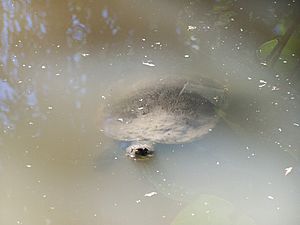Mary River turtle facts for kids
Quick facts for kids Mary River turtle |
|
|---|---|
 |
|
| Mary River turtle at the Australia Zoo | |
| Conservation status | |
| Scientific classification | |
| Genus: |
Elusor
|
| Species: |
macrurus
|
The Mary River turtle (Elusor macrurus) is a special kind of short-necked turtle. It is an endangered species, which means there are not many left in the wild. This turtle lives only in the Mary River in south-east Queensland, Australia. People knew about this turtle in the Mary River for almost 30 years. But it was only in 1994 that scientists officially named it a new species. Sadly, its numbers have dropped a lot. This is because they don't have many babies, and their nests are often raided.
Contents
Meet the Mary River Turtle
The Mary River turtle was officially described in 1994. This turtle is also known by some fun names. People sometimes call it the "green-haired turtle" or the "punk turtle." This is because algae can grow on its head or shell, making it look like it has green hair. The scientific name Elusor comes from a very old group of turtles. Most turtles from this group have disappeared over time.
What Does It Look Like?
The Mary River turtle is one of Australia's biggest turtles. Some have been found with shells over 50 centimeters (about 20 inches) long. Baby turtles are much smaller, only about 2 to 3.5 centimeters (less than 2 inches) long. Adult Mary River turtles have a long, smooth shell. The shell can be plain or have cool patterns. Its color can be rusty red, brown, or even almost black. The bottom part of its shell, called the plastron, is usually cream or pale pink. The skin is similar to the shell's color, often with salmon pink on its tail and legs. Its eyes can even be pale blue!
This turtle has a unique way of breathing. It can breathe underwater using a special part of its body called the cloaca. This means it can stay underwater for up to three days! But it still comes to the surface regularly to breathe air like other animals.
Special Features
Male Mary River turtles have a very long tail. It can be almost two-thirds the length of their shell. This long tail has special bones that most modern turtles don't have. Scientists are still trying to understand why it has this feature. Another unique thing about this turtle is its super long feelers, called barbels, under its chin.
Compared to other turtles in the area, the Mary River turtle has the smallest head. It also has the biggest back feet. These big feet help it be the fastest swimmer among them!
Threats to the Mary River Turtle
The Mary River turtle faces many dangers. When they are babies or young turtles, they can be eaten by red foxes, wild dogs, and even fish. The biggest danger is when animals like dogs, foxes, and goannas dig up their nests and eat the eggs.
The land around the Mary River has been cleared many times. This has made the water quality poor and caused a lot of mud to build up. Also, plants that don't belong there have grown along the river banks. These plants make it hard for the Mary River turtle to come ashore and lay its eggs.
The Mary River turtle has some cool ways to protect itself. It can blend into the muddy water, waiting for food to swim by. Its algae-covered shell also helps it hide from predators.
Life in the Mary River
We don't know a lot about how the Mary River turtle lives and behaves. It likes to live in parts of the Mary River that have flowing, clear water. It lives from Gympie to Maryborough. Its home includes shallow areas and deeper pools. It prefers water that is clear and moves slowly.
These turtles take a very long time to grow up. Female turtles are thought to become adults at about 25 years old. Males take even longer, around 30 years! Adult male turtles can sometimes be aggressive towards other males or other turtle species.
The Mary River turtle eats both plants and animals. It eats algae, clams, and other small creatures. This includes fish, frogs, and sometimes even baby ducklings!
Protecting the Mary River Turtle
In the 1960s and 1970s, the Mary River turtle was a popular pet in Australia. About 15,000 of them were sold in pet shops each year for a decade. Back then, they were called the "penny turtle" or "pet shop turtle."
Today, this species is officially listed as endangered. This means it is protected by laws in Queensland and across Australia. The international group IUCN also lists it as endangered. It's even on a special list called "Evolutionarily Distinct and Globally Endangered" (EDGE). This list highlights animals that are very unique and at high risk of disappearing. The Mary River turtle is Australia's most endangered freshwater turtle. It was once the second most endangered freshwater turtle in the world.
Good news! In 2007, a group called the Australian Freshwater Turtle Conservation and Research Association successfully bred these turtles in captivity. This was the first time this had happened, and they released the babies into the wild. In 2019 and 2020, a special hatchery was built along the Mary River. This hatchery helps protect the turtle nests and aims to help the Mary River turtle population grow in the future.
See also
Images for kids



